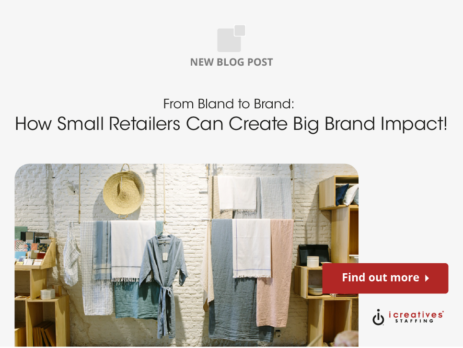How Small Retailers Can Create Big Brand Impact!
In the competitive retail landscape, small retailers often struggle to carve out a distinct identity that resonates with consumers. The transformation from a bland business to a recognizable brand is not just about changing a logo or enhancing a storefront. It involves a deep, strategic overhaul that touches every aspect of the business—from product presentation to customer interaction, and digital presence. For small retailers, this transformation is crucial as it can significantly amplify their market impact, attract more customers, and foster loyal relationships.
The journey from bland to brand requires a clear understanding of what makes a brand unique and appealing. This includes not only the visual elements of branding but also the values and stories that the brand embodies. Small retailers must leverage their agility and close customer relationships to craft a personalized brand experience that larger competitors often cannot match. This personalized approach can be a key differentiator in the market.
Moreover, the rise of digital technology offers unprecedented opportunities for small retailers to showcase their brand to a broader audience. Through effective use of social media, content marketing, and e-commerce platforms, small businesses can project a strong brand image that attracts and retains customers. However, navigating these digital waters requires careful planning and execution to ensure that every digital touchpoint reflects the brand’s values and aesthetic.
Collaboration with creative professionals can also play a pivotal role in this transformation. Whether it’s through engaging visual content, compelling storytelling, or innovative marketing campaigns, the right creative talent can elevate a small retailer’s brand to new heights. This collaboration can help in effectively communicating the brand’s message and engaging with the target audience on a deeper level.
Ultimately, the shift from bland to brand is about creating a memorable and engaging customer experience that stands out in a crowded market. By focusing on their unique strengths and values, and effectively utilizing digital tools and creative resources, small retailers can build a powerful brand presence that not only attracts but also retains customers, driving long-term success.

What are the key elements of a successful branding strategy for small retailers?
For small retailers aiming to make a significant impact in the market, a successful branding strategy involves several key elements. First and foremost, understanding the target audience is crucial. Retailers must know who their customers are, what they value, and how they prefer to engage with brands. This knowledge forms the foundation of all other branding efforts.
Consistency across all platforms is another critical element. Whether it’s in-store signage, online presence, or social media, every touchpoint should reflect the brand’s core values and visual identity. This consistency helps in building recognition and trust among customers.
Developing a unique value proposition (UVP) is also essential. This statement should clearly communicate what makes the retailer different from competitors and why a customer should choose them. A strong UVP can be a powerful tool in all marketing and communication efforts.
Engagement is another key aspect of a successful branding strategy. Small retailers should strive to create engaging, memorable experiences for customers, both online and offline. This could be through unique in-store experiences, interactive online content, or exceptional customer service.
Finally, leveraging the power of storytelling can greatly enhance a brand’s appeal. Sharing the history of the business, stories behind products, or customer testimonials can create emotional connections with customers, which is invaluable for brand loyalty.
By focusing on these elements, small retailers can develop a robust branding strategy that not only attracts customers but also engages them deeply, fostering loyalty and encouraging word-of-mouth promotion, which is often the most effective form of advertising for small businesses.
How can digital marketing be used to enhance a small retailer’s brand identity?
Digital marketing offers a plethora of tools and platforms that small retailers can use to enhance their brand identity effectively. The first step in leveraging digital marketing is to establish a strong online presence. This means having a professionally designed website that reflects the brand’s identity and values. The website should be user-friendly, mobile-responsive, and optimized for search engines to ensure it reaches the widest possible audience.
Social media is another powerful tool for building brand identity. Platforms like Instagram, Facebook, and Twitter allow retailers to showcase their products, share content that aligns with their brand values, and engage directly with customers. Regular, consistent posting and engagement on social media help in building a community around the brand.
Email marketing is also an effective digital marketing strategy for enhancing brand identity. By sending regular newsletters, promotions, and updates to their subscribers, small retailers can keep their brand top-of-mind and drive repeat business. Personalization of emails based on customer behavior and preferences can further enhance the effectiveness of this channel.
Content marketing can help small retailers establish authority and share their brand story. This could include blog posts, videos, podcasts, or infographics that provide value to customers and strengthen the brand’s identity. Content should be informative, engaging, and aligned with the brand’s values to resonate with the target audience.
Finally, online advertising, through platforms such as Google Ads or Facebook Ads, can increase brand visibility and attract new customers. Targeted ads can help small retailers reach their specific audience with precision, making the most of their marketing budget.
By strategically using these digital marketing tools, small retailers can significantly enhance their brand identity, reach a wider audience, and build stronger customer relationships, all of which are crucial for long-term success in the retail market.

What role do visuals play in transforming a small retailer into a recognizable brand?
Visuals are a critical component in the branding toolkit, especially for small retailers looking to make a big impact. The visual elements of a brand, including the logo, color scheme, typography, and imagery, are often the first things that potential customers notice. These elements need to be carefully designed to convey the brand’s personality and values at a glance.
A well-designed logo acts as the face of the brand. It should be distinctive, memorable, and scalable, working well across various mediums from store signs to social media icons. The color scheme also plays a significant role in branding, evoking emotions and associations that can make the brand more relatable and appealing to its target audience.
Typography should not be overlooked, as the style of text used in branding materials can significantly affect how the brand is perceived. Choosing the right fonts can help to communicate the brand’s message more effectively and ensure readability across all platforms.
Imagery, including photographs and illustrations, helps to tell the brand’s story and showcase products in a way that resonates with the target audience. High-quality, consistent imagery not only enhances the aesthetic appeal of the brand but also contributes to its authenticity and credibility.
Moreover, the overall design of the retail space, packaging, and promotional materials should reflect the brand’s visual identity. This consistency helps to reinforce the brand image and can make the shopping experience more immersive and memorable for customers.
Investing in professional design services can be highly beneficial for small retailers. Professionals can help to create a cohesive visual identity that effectively communicates the brand’s message and appeals to the target audience. This investment can pay off significantly by increasing brand recognition and customer loyalty.
Ultimately, visuals are not just decoration; they are a powerful communication tool that can help small retailers stand out in a crowded market. By carefully crafting and consistently applying visual elements, small retailers can transform into recognizable brands that attract and retain customers.
Can customer feedback influence brand transformation for small retailers?
Customer feedback is an invaluable resource for small retailers looking to transform their brand. It provides direct insights into what customers like and dislike, helping businesses to refine their products, services, and overall brand experience. Actively seeking and responding to customer feedback shows that a brand values its customers’ opinions, which can enhance customer loyalty and satisfaction.
Feedback can come from various sources such as in-store interactions, online reviews, social media comments, and customer surveys. Each of these channels provides different types of insights, and together, they can offer a comprehensive view of customer perceptions and expectations.
One of the key benefits of customer feedback is that it allows retailers to identify and address issues quickly. Whether it’s a problem with a product, a customer service issue, or a misunderstanding about the brand’s values, resolving these issues promptly can prevent negative word-of-mouth and demonstrate the brand’s commitment to customer satisfaction.
Moreover, feedback can also highlight what the brand is doing right. Positive feedback can be used in marketing materials as testimonials, which can attract new customers and reinforce the brand’s strengths. It can also guide the development of new products or services that align with customer desires and expectations.
Additionally, engaging with customers through feedback can help to build a community around the brand. This engagement can foster a sense of ownership and loyalty among customers, making them more likely to become repeat buyers and brand advocates.
However, it’s important for small retailers to approach feedback constructively. Not all feedback will be useful or actionable, and it should be evaluated critically before making any major brand decisions. Retailers should also ensure that they are gathering feedback from a diverse range of customers to get a well-rounded view of the brand’s impact.
In conclusion, customer feedback is not just a tool for resolving issues but a strategic asset that can inform and guide the brand transformation process. By actively seeking, analyzing, and acting on customer feedback, small retailers can refine their brand to better meet customer needs and enhance their market position.
What strategies can small retailers use to maintain brand consistency across multiple channels?
Maintaining brand consistency across multiple channels is crucial for small retailers aiming to establish a strong and recognizable brand. Consistency helps to build trust and recognition, making it easier for customers to identify the brand regardless of the platform or medium. Here are several strategies that small retailers can use to ensure brand consistency:
Firstly, developing a comprehensive brand guideline is essential. This document should detail the brand’s visual elements, tone of voice, and overall messaging. It should be used as a reference for all branding efforts to ensure consistency across all channels, including digital marketing, social media, packaging, and in-store displays.
Training staff thoroughly on the brand’s values and visual identity is also important. Employees should understand how to represent the brand accurately, whether they are creating social media content, responding to customer inquiries, or interacting with customers in-store.
Utilizing templates for marketing materials can help maintain visual and tonal consistency. Templates for social media posts, email newsletters, and promotional materials ensure that all communications are aligned with the brand’s guidelines.
Regular audits of all brand touchpoints can also be beneficial. This involves reviewing the website, social media profiles, marketing materials, and in-store branding to ensure that they are in line with the brand guidelines. Any discrepancies should be corrected promptly to maintain consistency.
Finally, leveraging technology can aid in managing brand consistency. Tools that manage social media posts, customer communications, and content creation can help ensure that all outputs are consistent with the brand’s established identity.
By implementing these strategies, small retailers can maintain a consistent brand identity across all channels, enhancing brand recognition and customer loyalty. This consistency is key to building a strong brand that customers trust and prefer over competitors.
Conclusion
The transformation from a bland business to a recognizable brand is a journey that requires strategic thinking, creativity, and a deep understanding of the target audience. For small retailers, this transformation is not just about survival but about thriving in a competitive market by establishing a unique and appealing brand identity.
By focusing on key elements of branding, leveraging digital marketing, investing in professional visuals, listening to customer feedback, and maintaining consistency across all channels, small retailers can create a strong brand presence that resonates with customers and stands out in the market.
The role of creative professionals cannot be underestimated in this process. Whether it’s through designing compelling visuals, crafting engaging content, or developing innovative marketing strategies, their expertise can significantly enhance the brand’s appeal and effectiveness.
Ultimately, the goal of transforming from bland to brand is to build a loyal customer base that not only returns repeatedly but also advocates for the brand to others. This customer loyalty is the ultimate testament to a successful brand transformation, driving long-term success and growth for small retailers.
In conclusion, while the challenges are many, the opportunities for small retailers to distinguish themselves through effective branding are even greater. With the right strategies and resources, any small retailer can transform into a powerful brand that captures the hearts and minds of consumers.
For further insights on enhancing your brand through creative professionals, explore our articles on hiring remote illustrators, attracting top animation talent, and mastering job interviews.
In today’s competitive market, finding the right creative and marketing expert can be a challenge. But with icreatives, you’re in experienced hands. With 37 years in staffing and a track record of matching more than 10,000 employees to over 1,000 companies worldwide, we know how to connect you with the best. Plus, you only pay if you hire—there’s no risk, only results.Ready to find your perfect creative or marketing expert? HIRE WITH ICREATIVES today!











